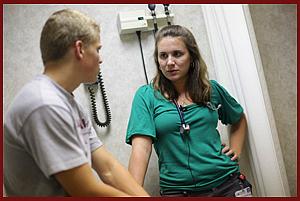Finding health access inequalities in your state

The idea for my recent project about the health care crisis in Oklahoma came from a report by the New England Journal of Medicine that ranked the state as the worst for access to health care when health care reform measures kick in.
I started with the idea of writing a story, but quickly realized the issue was much bigger than a weekender. So many factors are leading to what I began to realize is a serious problem for Oklahoma.
The data
I began by requesting the list of all licensed medical doctors and doctors of osteopathy from their respective licensing boards. I requested name, address, date of graduation from medical school and specialty. I didn't include physician assistants in the request because I wanted to look exclusively at physicians.
I received the data in an electronic format and handed it over to the quite capable database editor. I asked him to create a list of all specialties and break those down by county. That way I could tell how many oncologists or cardiologists are in the state in general and in various regions of the state. I also asked the data team to clean up the addresses by geocoding them. The address field can be messy and incomplete, so in some cases we had to rely on the ZIP code.
I put that data into a Google Fusion table to display the physicians as dots on a map. That provided an easy way to tell where physicians were concentrated and was a good visual element for the story in print and on the Web. I did the same thing with each specialty, so I could see where they were lacking.
Getting the faces
The data is powerful, but as we all know, the people affected by an issue are what make a story connect with the reader. To find people to interview for this series, I spoke with social service groups and those in charge of the free clinics in the area. I waited at the closest bus stop to the clinics and rode the transportation system the local federally qualified health center uses.
I asked doctors to point me to patients who had faced difficult in receiving care. I talked to social workers who had clients that rarely or never saw the doctor and worked with medical and public health students who were in the field studying barriers to access.
Experts, academics and health professionals were also key for getting information and patient perspectives in the story. I interviewed nurses, physician assistants, the head of the federally qualified health center and numerous professors and doctors now working in an academic setting. Although they were vital for basic information, it was also important to talk to them about the emotions they felt while realizing the trouble their clients faced. People who had trouble getting health care were an obvious part of the story, but those trying to fix the situation were important faces as well.
Putting it together
To decide how many stories to include in the series, I had to start writing. I started threading everything together and grouped what I was writing by general theme. It became clear that I had the most information about geographic disparities and the growing role of mid-level practitioners.
I realized that I needed to introduce the issue, so I took my best face, a rural family practice doctor, and tied him into the basic rolling out of what my series would address. The other two topics I wanted to focus on were transportation issues and possible technological solutions to the problems. These naturally fit as sidebars.

